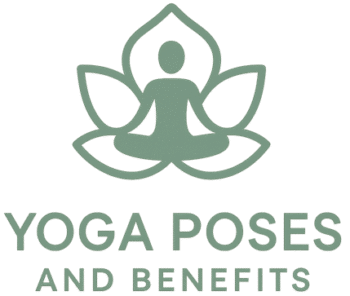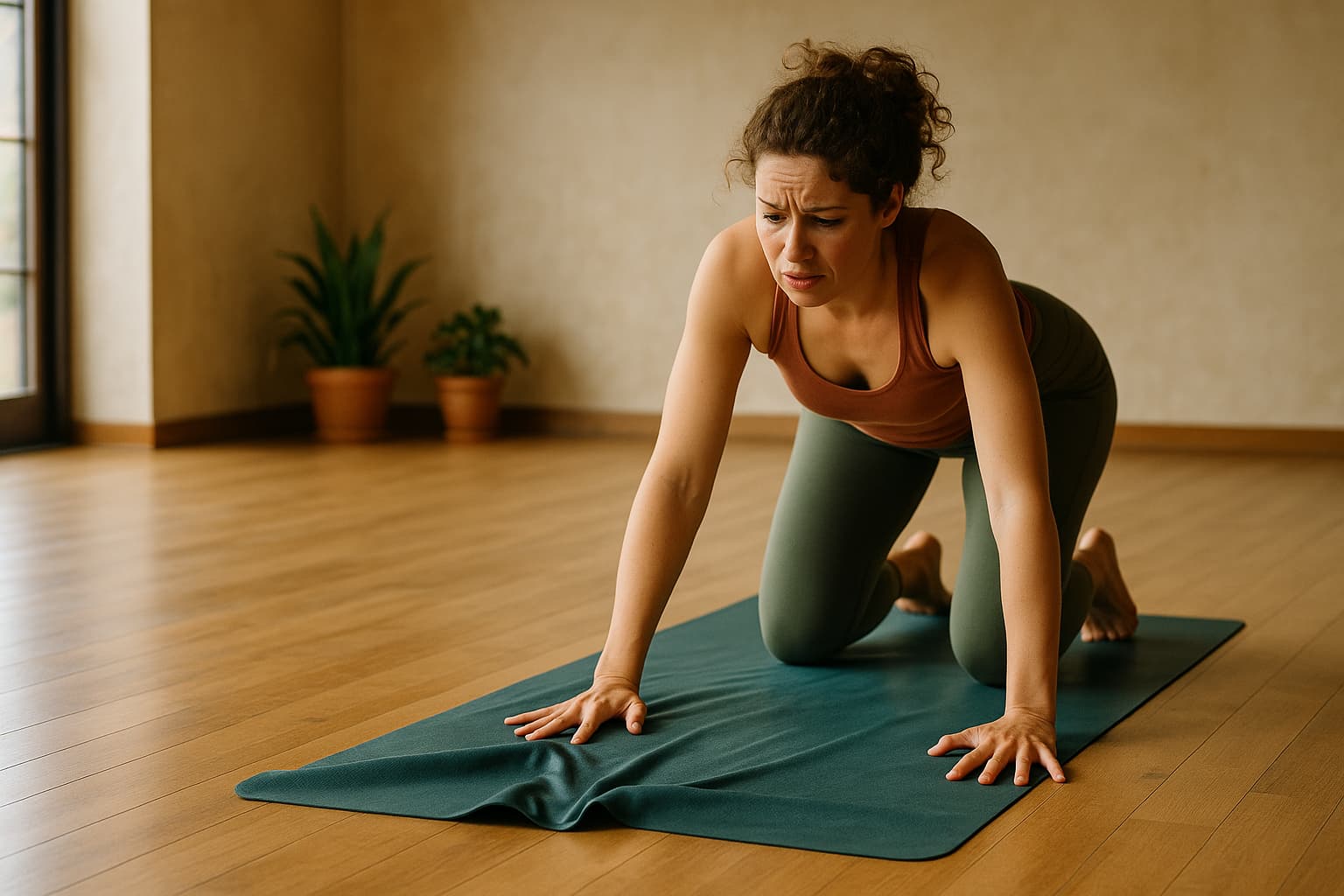Why a Stable Yoga Mat Matters
A secure yoga foundation protects joints, supports balance, and allows deeper focus on postures instead of managing constant slide. Even small shifts under the mat interrupt stability during poses like Warrior II or Triangle Pose, forcing stabilizing muscles to work harder. A dependable yoga mat anchors hands and feet so transitions between standing asanas and seated poses flow naturally. Strong traction also enhances mindfulness, letting practitioners stay present and connected to breath and alignment throughout practice.
- Select a mat with reliable grip to support grounded asanas such as Downward-Facing Dog
- Check edges and the underside regularly for wear that reduces stability
Practicing with a mat that stays in place creates a safe, predictable environment whether in a heated studio, on hardwood floors, or during outdoor yoga. Consistency ensures smoother sequences and a stronger sense of grounding during meditation and pranayama.
Choosing the Right Mat for Your Practice
Different yoga styles demand different mat qualities. For flowing sequences in Vinyasa or Ashtanga Yoga, a lightweight mat offers portability but may compress quickly. Denser natural rubber mats provide steady support for Restorative Yoga or Yin sessions where longer holds require joint comfort. Eco-conscious options like cork mats or Manduka’s eko line combine sustainability with strong mat grip. Feeling surfaces in person is best since coatings and finishes can dramatically affect traction.
- Match thickness to flooring: hardwood requires more padding than carpet
- Check bottom texture; undersides should cling securely to studio floors
If palms perspire quickly during hot yoga or Bikram sessions, prioritize topsheets that maintain friction under heat. Measure width and length to fit your stance, ensuring poses like Wide-Legged Forward Fold feel unrestricted. High-quality mats resist fraying and stretching, saving money over time while improving overall practice performance.
Thickness and Material of the Mat
Thickness affects comfort and stability equally. Extra-cushioned mats may feel pleasant for Child’s Pose but create wobble during Tree Pose. Thin models maintain floor connection but can irritate knees. Natural rubber delivers excellent traction and responsiveness, while PVC mats emphasize durability and simpler cleaning. Practitioners focused on balance postures benefit most from medium-density mats that resist compression and provide consistent feedback.
- 3–5 mm works well for everyday flows; 6 mm cushions restorative or Yin Yoga
- Check edges; sturdy borders won’t fold under weight during Plank Pose
Room conditions also matter. In humid studios or heated classes, compounds respond differently. Testing mats with sun salutations helps gauge traction. Travel versions sacrifice padding for portability, so pair them with a yoga towel when practicing abroad or outdoors.
Textured Surfaces to Prevent Slipping
Surface patterns often determine traction more than thickness. Cross-hatch designs, cork finishes, or closed-cell ridges help channel sweat away in asanas like Downward-Facing Dog or Chaturanga. Choose textures that hold steady under load yet release smoothly during transitions. In heated flows or Bikram classes, textured topsheets remain reliable even as perspiration builds, reducing slipping risks.
- Test by pressing fingertips lightly; resistance signals effective grip
- Inspect the topsheet for consistency; uneven textures cause slide spots
Check undersides too. Even the best textured surface won’t prevent slipping if the bottom layer skids on polished wood. Make sure both sides work together to anchor practice.
Practical Tips to Prevent Slipping During Yoga
Preparation and technique form the first line of defense. Clear the mat surface of dust, warm up joints, and distribute weight evenly. Spread fingers wide, press into knuckles, and engage leg muscles so pressure spreads across multiple contact points. During hot yoga or Power Yoga, keep a small towel close to manage sweat before it becomes a slipping hazard.
- Reestablish hand placement with finger splay before weight-bearing poses
- Dry palms and soles instead of forcing through slide
By approaching practice with proactive adjustments, you prevent slipping before it disrupts focus, maintaining mindfulness throughout each sequence.
Clean Your Yoga Mat Regularly
Sweat, oils, and dust weaken grip over time. After class, wipe the yoga mat with a mild vinegar solution, tea tree oil spray, or gentle soap mix, then air dry fully before rolling. Deep cleaning weekly preserves texture, while quick wipes after every session prevent buildup. Avoid harsh chemicals that stiffen or glaze surfaces.
- Use microfiber cloths for gentle but effective cleaning
- Lay flat in shade; direct sun breaks down mat material
Clean mats maintain reliable grip during poses like Warrior III, supporting safe and steady balance practice.
Use a Yoga Towel or Yoga Towels
A yoga towel creates instant traction by absorbing sweat and adding texture. Microfiber models grip more as they dampen, ideal for Hot Yoga or Bikram sessions where perspiration is heavy. Full-length covers protect the entire yoga mat, while smaller towels reinforce common slip zones at the top edge. Yoga towels are especially useful on yoga mats for hot yoga practices because they prevent pooling moisture and maintain consistent grip throughout long, heated sequences. Wash towels frequently with mild detergent to preserve fibers and performance.
- Mist lightly if hands are dry before class
- Choose designs with corner pockets to prevent shifting
This simple addition prevents slipping, extends mat life, and improves comfort in flowing sequences or long holds, especially in heated studios.
Adjust Your Grip and Alignment in Yoga
Improved technique often outperforms new gear. Spread fingers in Downward-Facing Dog, root through the index knuckle, and pull forearms inward to build tension. In standing asanas like Warrior II, press big toes into the mat while lifting arches to engage legs and stabilize hips. Small stance adjustments distribute weight more evenly during transitions from Plank to Upward-Facing Dog.
- Stack joints in vertical lines to reduce strain
- Engage the core and glutes for added balance
These refinements allow the yoga mat to support alignment naturally, reducing slip while conserving energy for deeper exploration of poses.
Extra Gear and Tricks to Stop Yoga Mat Slip
Accessories can dramatically enhance traction. Grip powders, rosin bags, corner clips, or small silicone pads each address slipping differently. Arm-balance enthusiasts benefit from targeted grip pads during Crow Pose, while floor-side grippers stabilize mats on polished hardwood. Introduce one tool at a time and evaluate its impact during an entire session.
- Experiment during warm-ups before attempting advanced asanas
- Record results to discover the best combinations for your mat
When gear and alignment strategies complement each other, confidence and mindfulness replace concerns about slipping.
Place a Yoga Towel Over Slippery Yoga Surfaces
Studios with glossy floors or humid conditions often create slippery yoga environments. A fitted yoga towel acts as a barrier, absorbing moisture and adding texture. Some towels feature alignment lines, making it easy to find consistent hand and foot placement in Downward Dog or Plank Pose. Rolling the front edge slightly builds a natural stop for forward sliding.
- Smooth the towel outward to prevent ripples under feet
- Avoid fabric softeners that coat fibers and reduce grip
This setup stabilizes practice whether in heated studios or outdoor yoga sessions.
Try Non-Slip Sprays and Accessories
Grip-enhancing sprays renew traction on older mats. Apply a light coat, let it settle, then test with a few sun salutations. Use sparingly to avoid sticky residue. Combine sprays with minimal accessories like yoga socks or fingerless gloves for additional support in sweaty flows.
- Apply only as needed; overuse attracts dust
- Store in cool places to maintain formula stability
When used correctly, sprays extend mat life and restore steady footing in demanding classes.
Long-Term Care and Maintenance of Your Yoga Mat
Consistent care extends mat performance. Rotate orientation to distribute wear, air dry after each class, and roll loosely to prevent deep creases. Wipe away salt and sweat crystals promptly to avoid surface abrasion. These routines keep mats comfortable for poses ranging from Child’s Pose to Headstand.
- Use separate cloths for sweat and cleaning tasks
- Replace mats seasonally if practicing daily in heated environments
Predictable maintenance routines keep mats dependable and ready for both daily yoga and occasional meditation sessions.
Proper Storage to Avoid a Slippery Mat
Storage impacts mat longevity. Heat, moisture, or tight rolls weaken materials and create curls at the edges. Always dry thoroughly, then roll with the practice surface facing outward. Rotate rolling direction weekly to distribute stress evenly.
- Hang mats over wide bars when possible for quicker drying
- Keep storage bags clean to prevent dust transfer
Thoughtful storage keeps mats responsive, reduces slipping, and simplifies setup before practice.
When to Upgrade Your Yoga Mat
All mats wear out. Replace your yoga mat when grip fades despite cleaning, when cushioning flattens, or when edges fray. Daily practitioners in hot yoga studios will notice faster degradation. Modern mats from brands like Manduka, Jade Yoga, or Liforme combine sustainability with advanced grip and alignment guides.
- Look for even texture, consistent density, and firm underside traction
- Use demo programs to test fit before purchase
Retain older mats for outdoor or travel sessions, and let the new one support advanced practice. Timely upgrades ensure safe, steady alignment in every class.
Stay Grounded in Your Yoga Practice
Stability requires more than one solution. Choosing the right yoga mat, integrating towels, and refining alignment in asanas create dependable grip. Regular cleaning with natural sprays, mindful storage, and timely upgrades keep mats effective across Hatha, Vinyasa, or Yin Yoga sessions. With attention to both gear and practice habits, slipping fades into the background and each class becomes an opportunity to deepen focus, improve alignment, and cultivate mindfulness on a stable foundation.

